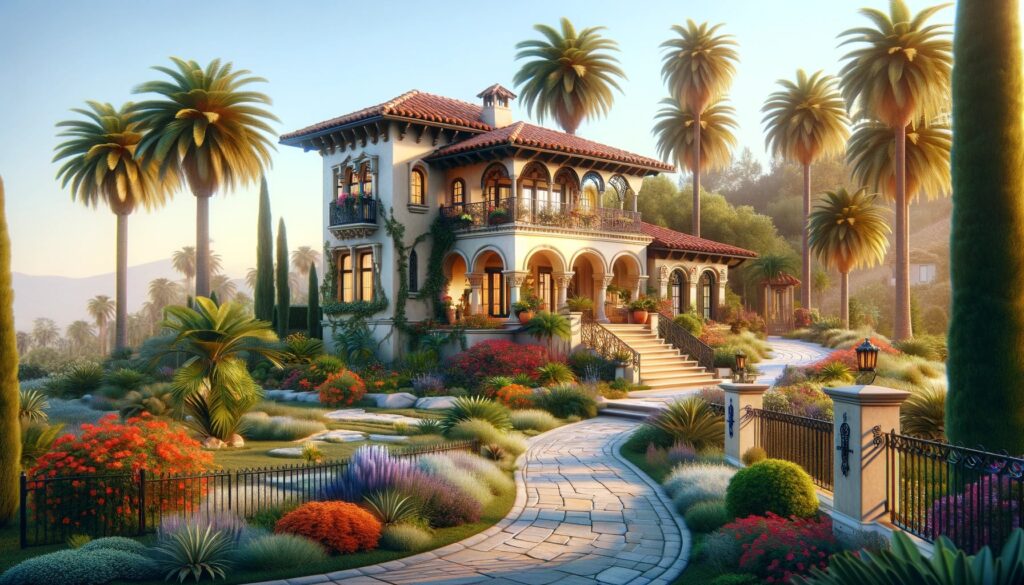Introduction
Spanish-style homes are synonymous with charm, elegance, and a timeless aesthetic that has captivated homeowners and architects alike for centuries. These homes, with their distinct architectural elements and cultural significance, continue to be a popular choice for those seeking a blend of historical beauty and modern comfort. Architectural Elements of Spanish Homes
Historical Background
The origins of Spanish-style architecture can be traced back to the early Spanish colonization of the Americas. Drawing heavily from Moorish and Mediterranean designs, these homes were initially built to suit the warm climates of Spain and later adapted to the similar climates of California, Florida, and the Southwestern United States.
Key Characteristics of Spanish-Style Homes
White Stucco Walls
One of the most recognizable features of Spanish-style homes is their white stucco walls. This material not only provides a clean and crisp look but also serves practical purposes, such as regulating temperature and providing durability against the elements.
Red Tile Roofs
The red tile roof, often made from clay, is another hallmark of Spanish-style homes. These roofs are not only aesthetically pleasing but also highly functional, offering excellent insulation and longevity.
Courtyards and Patios
Central courtyards and patios are integral to Spanish-style homes, offering a serene outdoor space that blurs the line between indoor and outdoor living. These areas are often adorned with lush greenery, water features, and intricate tile work.
Exterior Features
Arched Doorways and Windows
Arched doorways and windows are a nod to the Moorish influence on Spanish architecture. These graceful curves add an element of softness and sophistication to the home’s exterior.
Wrought Iron Details
Wrought iron is frequently used in Spanish-style homes, from gates and railings to light fixtures and window grilles. This material adds both security and decorative flair.
Wooden Beams and Carvings
Exposed wooden beams and intricately carved wooden details are common in Spanish-style homes, adding warmth and a sense of craftsmanship to the design.
Interior Elements
Terracotta and Ceramic Tiles
Inside Spanish-style homes, terracotta and ceramic tiles are often used for flooring, staircases, and decorative accents. These tiles bring a vibrant and earthy feel to the interior spaces.
Exposed Wooden Beams
Exposed wooden beams, often found on ceilings, provide a rustic charm and highlight the home’s architectural integrity.
Fireplaces
Fireplaces are a cozy and functional feature in many Spanish-style homes, often designed with intricate tile work and traditional motifs.
Architectural Layout
Open Floor Plans
Spanish-style homes typically feature open floor plans that promote a flow of movement and a sense of spaciousness. This layout is ideal for both family life and entertaining.
Connection between Indoor and Outdoor Spaces
A seamless connection between indoor and outdoor spaces is a defining characteristic of Spanish-style homes. Large windows, doors, and courtyards facilitate this integration, enhancing the home’s livability.
Use of Natural Light
Spanish-style homes are designed to maximize natural light, with strategically placed windows and open spaces that allow sunlight to flood the interior.
Landscaping and Outdoor Spaces
Lush Gardens
The gardens of Spanish-style homes are often lush and vibrant, featuring a mix of native and exotic plants that thrive in warm climates.
Water Fountains
Water fountains are a common feature in Spanish-style landscaping, providing a soothing and aesthetic element to courtyards and gardens.
Outdoor Kitchens and Living Areas
Outdoor kitchens and living areas are perfect for enjoying the pleasant climate and entertaining guests, further blurring the line between indoor and outdoor living.
Regional Variations
Californian Spanish-Style Homes
In California, Spanish-style homes often incorporate Mission Revival elements, with smooth stucco walls, red tile roofs, and arched corridors.
Southwestern Influences
In the Southwest, Spanish-style homes may feature adobe walls, flat roofs, and courtyards designed to stay cool in the desert heat.
Floridian Touches
Florida’s Spanish-style homes often emphasize tropical landscaping, expansive porches, and large windows to take advantage of the coastal views and breezes.
Cultural Significance
Symbolism in Design Elements
Many elements of Spanish-style homes hold cultural and historical symbolism, reflecting the heritage and traditions of the regions where they originated.
Role in Community and Family Life
Spanish-style homes are designe to foster community and family life, with open spaces and communal areas that encourage social interaction and togetherness.
Modern Adaptations
Integration of Modern Amenities
While maintaining their historical charm, modern Spanish-style homes are often equippy with contemporary amenities, such as updated kitchens, smart home technology, and energy-efficient systems.
Sustainable and Eco-Friendly Practices
Many new Spanish-style homes incorporate sustainable building practices and materials, making them eco-friendly without sacrificing aesthetic appeal.
Famous Spanish-Style Homes and Architects
Notable Examples
There are many famous examples of Spanish-style homes, from historic estates to modern interpretations. These homes often serve as inspiration for new designs.
Influential Architects
Architects like George Washington Smith and Wallace Neff have left a lasting legacy with their contributions to Spanish-style architecture, blending traditional elements with innovative design.
Decorative Elements
Use of Color
Color plays a significant role in Spanish-style homes, with earthy tones, vibrant tiles, and colorful accents bringing life to both interiors and exteriors.
Artistic Tile Work
Intricate tile work is a staple in Spanish-style homes, used for everything from flooring to decorative murals and backsplashes.
Unique Light Fixtures
Handcrafted light fixtures, often made from wrought iron or featuring intricate glasswork, add a distinctive touch to Spanish-style homes.
Building Materials
Traditional Materials Used
Traditional Spanish-style homes use materials like stucco, clay, and wood, chosen for their durability and aesthetic appeal.
Modern Substitutes
Modern adaptations of Spanish-style homes may use alternative materials that mimic the look and feel of traditional ones while offering enhanced performance and sustainability.
Maintenance and Preservation
Caring for Stucco and Tile
Regular maintenance of stucco walls and tile roofs is essential to preserve the beauty and integrity of Spanish-style homes.
Preserving Historic Integrity
When renovating or restoring Spanish-style homes, it’s important to maintain the original design elements and materials to preserve their historical and cultural significance.
Conclusion
Spanish-style homes offer a unique blend of historical charm and modern comfort, with their distinctive architectural elements and timeless appeal. Whether you’re drawn to their white stucco walls, red tile roofs, or lush courtyards, these homes provide a beautiful and functional living space that celebrates both tradition and innovation.
FAQs
What defines a Spanish-Style home?
A Spanish-Style home is characterize by its white stucco walls, red tile roofs, arched doorways and windows, wrought iron details, and an emphasis on indoor-outdoor living with courtyards and patios.
Are Spanish-Style homes energy efficient?
Yes, many Spanish-Style homes are design to be energy efficient, utilizing thick stucco walls and clay tile roofs for insulation, and maximizing natural light and ventilation.
How can I incorporate Spanish-Style elements into my existing home?
You can incorporate Spanish-Style elements by adding features like terracotta tiles, wrought iron fixtures, arched doorways, and stucco finishes. Landscaping with lush gardens and water features can also enhance the Spanish aesthetic.
What are some common misconceptions about Spanish-Style architecture?
A common misconception is that Spanish-Style homes are only suitable for warm climates. While they are design to thrive in such environments, they can be adopt to various climates with the right materials and design adjustments.
Are Spanish-Style homes expensive to maintain?
Maintenance costs for Spanish-Style homes can vary. Stucco and tile require regular care, but their durability often results in long-term savings. Proper maintenance of these materials ensures the home remains beautiful and functional for years to come.

